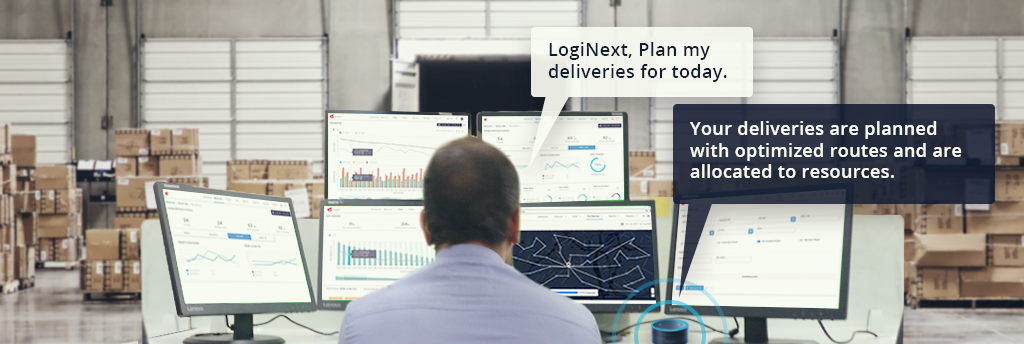Voice Controlled Planning and Routing for Logistics Management
Logistics automation and streamlining require adaptability and scalability in terms of technology backed innovation. It is about finding the right solution which can be better ‘enabled’ through technology. We continually work on getting the right technology to further automate and improve logistics movement. We worked towards creating the best solution to solve real-world problems seen in logistics and field workforce management. It took months of coding and designing but we hit that sweet spot with voice-controlled automation of logistics processes. I am talking about conversing with machines. And have the machines converse amongst each other. The next phase of connectivity is here. Adaptation and adoption of this technology would lead to the faster evolution of services and product solutions.
At LogiNext, we recently integrated with Alexa, Google Assistant, Cortana, and Siri. Previously a logistics or sales manager had to log in to our product dashboard to check the location or the status of any in-transit delivery, vehicle, or agent. Now, the manager can simply relax and instruct their personal assistant to fetch the information for them.
“Alexa! Ask LogiNext to plan my deliveries for today.”
The mechanics are a little more in-depth than that, but this is how the final statement would be. We have successfully integrated a multitude of skills within the assistant so that it can access all relevant and actionable information directly from our system and report it to the user.
“Your deliveries are planned with optimized routes and are allocated to resources.”

Imagine a world where all you need to do is speak to your personal assistant about any resource or parcel and even plan a schedule around it. You can plan your deliveries while you travel in your car. You can track the exact location of any vehicle simply by asking a question. Automation of processes has reached its tipping point, and LogiNext is ready to lead you to the next level of efficiency.
Let’s consider what has been done here.
Enterprise System Interactions and Communication
The core issues which technology can solve within logistics processes is to enable better visibility, control, and transparency across the end-to-end movement of resources. This would eventually bring down costs and increase efficiency along with profitability.
Logistics management involves mutual interactions of multiple stakeholders and services including carrier services, third-party logistics partners, distributors, warehouse management systems, transport management systems, workforce management systems, tracking and reporting services, management information systems, enterprise resource planning systems, etc. Information moves through multiple systems and along multiple stakeholders. There are two factors at play here.
- Time spent on information forwarding: There is a time cost involved with the digital or physical movement of information. This involves the manual intervention time (and hence the cost of the resource) while feeding in information and reviewing analytics, and the time delay as the information moves from one system/stakeholder to another.
- Quality and consistency of information transfer: As the information is handed over multiple times, there are situations when the language, structure, and consistency of information is affected.
The time factor and quality are related to each other. However, with LogiNext’s voice-controlled automation, this can be minimized. Not just reporting and analytics, the manager can initiate planning of schedules and allocate deliveries and tasks just by speaking about it. Multiple interlinking and integrations would help the personal assistant have better and faster ‘conversations’ with other systems and give a much clearer picture about the progress, status, and reports of multiple processes, and even initiate some of these processes. The authenticity of direct information passing through the system without having to go through intermediaries significantly decreases the probability of communication errors.
Process Automation: Allocation, Dispatch, Tracking, and Updates
Logistics automation, as we know, has the potential to save a lot of time and cost. Saving time in processing and planning for trips and routes means that the total turnaround time for the eventual trip would be shorter. Logistics automation simplifies this process and makes logistics and resource movement simpler.
With LogiNext’s voice-controlled automation, managers can verbally communicate their directives to the system. If they want a specific parcel to be assigned to a courier who is more well-equipped to deliver it, they can simply say it and it would be done. They are not required to search through a list of orders for the parcel and then browse through a list of available couriers to assign the same. It can all be automated by a single skill-defined command. Similarly, tracking and updates can be made much simpler with the use of such voice-controlled assistants. As we saw earlier, all it takes is for a manager to ask the right question about the location or status of any delivery and it would be reported back immediately. The agility and responsiveness gained by the quick and correct communication of information would help companies react better and faster in key situations.
Entire Process Visibility and Transparency
There are many events that a courier, agent, or vehicle undergoes while on a trip. These involve interactions with traffic, weather, or the eventual customer experience. If there is a delay along an in-transit delivery which may affect the original service level agreement of SLA (companies have SLAs which must be met such as service or delivery time, parcel safety, speeding of delivery vehicles, etc.). These SLAs are tracked in real-time by LogiNext. Now, if the manager wants to access the tracking and delivery updates in real-time, they no longer must access the system and search the same. They can ask the assistant to do it for them.
The manager can ask the assistant, ‘Ask LogiNext, which are my high priority alerts?’. These parameters and information calling-terms like ‘high priority alerts’ are already defined as a skill. The assistant would talk to LogiNext’s core system and extract the data. The assistant would then vocalize all the alert and update messages marked as ‘high priority’. These alerts would mostly cover the events like extended detention of vehicles, delivery failure, and other such actionable items. This increases the visibility and transparency of the system. The manager can easily pull up any relevant information and make an informed decision using the same.
Language and Dialect Localization in Emerging Markets
Logistics and field workforce optimization as a solution is developing faster in the SEA and South Asia as compared to more mature markets. The tech and road infrastructure in emerging markets may come up with some bottlenecks. These bottlenecks would then would have to be overcome while sustaining logistics and delivery efficiency. The best way to handle these bottlenecks is increased visibility of operations for every stakeholder. The client at the headquarters must know which in-transit vehicles are delayed or are in breach of an SLA. A hub manager must know the exact ETAs of each vehicle coming into their hub so that they can play their workforce for offloading or loading. When visibility at all levels of operations are synchronized, the movement of goods become faster and more efficient.
Voice-controlled automated can make this process agiler. And the leveling marker is the language and dialect neutrality built within the personal assistant. This means that even a local hub manager can operate Alexa in his or her own language or dialect. There doesn’t have to be any gap in information flow due to any language barrier. This is big leap forward in true glocalization of logistics and supply chain movement.
Adoption of Technology Across Companies
Perhaps the most striking benefit of LogiNext’s voice-controlled automation feature is its ease-of-use. Almost anyone can use the personal assistant without any hassle. It doesn’t matter if they are tech-savvy. They can have their personal assistant set-up and all they have to do is ask questions as and when required. It has the shortest learning curve in technology backed automation. The ease-of-use and one-stop solution point would help drive process integrations and innovation as the adoption of technology increases across the company.
Accurate and timely information transfer can help initiate appropriate actions which can, in turn, either save costs or increase efficiency or both at the same. Voice-controlled automation can be the perfect playing field where experienced individuals who preferred traditional ways due to their lack of technical expertise can now partake with their intellect and insights. The implications of such automation are beyond just numbers, it can drive a change in the way things are done and eventually result in better strategic balance within companies.
222 1








Pingback: LogiNext-Blog | How has Internet of Things changed the lives of businesses worldwide?